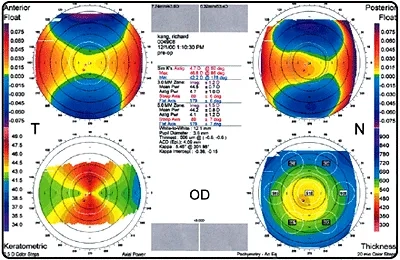Diagnostic LASIK Technology
At London Eye Centre, we utilize several machines during a patient’s free consultation to get a better idea of their visual situation. These information we gather during this stage then allows us to suggest the optimal treatment for your eye condition(s).
Pentacam
The Pentacam is a comprehensive eye scanner which provides data critical to the planning of the treatment.
The images produced during a scan display the anterior segment (front portion) of the eye by rotating Scheimpflug camera measurements. This process supplies pictures in three dimensions. The measurement process lasts less than two seconds, and minute eye movements are captured and corrected simultaneously. By measuring 25,000 true elevation points, precise representation, repeatability and analysis are guaranteed.
The Pentacam provides a three-dimensional chamber analysis of the complete anterior segment of the eye, corneal topography of both the front and the back of the cornea, thickness measurements across the entire diameter of the cornea.
The Pentacam is the first instrument that provides a truly accurate measure of both the front and back surfaces of the cornea. London Eye Centre was the first laser vision correction facility in Vancouver to acquire and use the Pentacam extensively for planning and screening laser vision correction patients.
Orbscan topography
A topography unit is a machine that takes a specialized photo of the cornea, the front transparent window of the eye. The resulting photo is a topographic map of the corneal surface, which gives a precise image of the particulars of your eye. This map shows the bumps and valleys on the corneal surface and is used to ensure the cornea is regular and can be treated with the laser. The resulting images give a clear idea of your cornea’s topography, and is therefore essential in determining whether or not you are a candidate for laser eye surgery.

Orbscan topography not only allows your surgeon to detect irregularities on the front surface of the cornea, but also maps the posterior corneal surface. Conventional topography machines can only give information about the front surface. Orbscan topography can also determine whether the back surface of one’s cornea is healthy, which is essential for safety reasons.
A pachymetry unit is a machine that takes a measurement of corneal thickness. It is vital to assess this to determine if there is adequate thickness to create the flap and to perform the laser ablation during a procedure, as people with thin corneas may not have enough tissue for a primary (or a secondary) treatment.
Conventional pachymetry units take measurements at one point on the cornea. This point is where the probe of the pachymeter touches the cornea, usually in the center. The Orbscan technology takes measurements optically without touching the cornea. This allows a measurement reading for the entire cornea; rather than a measurement at just one point. The ability to determine the thickness of the entire surface ensures that a thin point is not missed.
Are you ready to start living free of glasses and contacts?
Call us or book a free, no-obligation consultation online today: